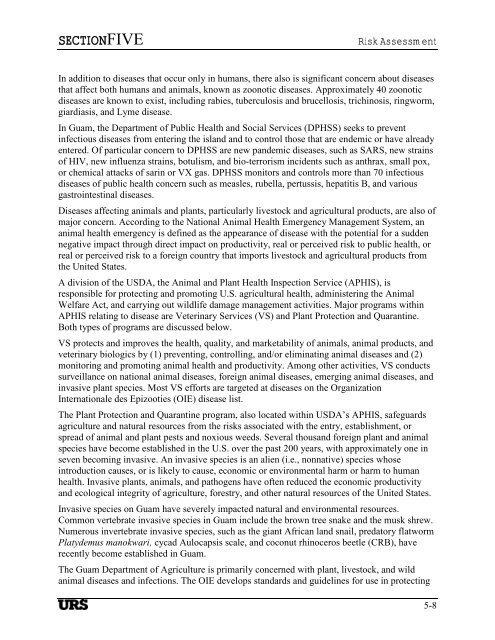Guam Hazard Mitigation Plan - Western States Seismic Policy Council
Guam Hazard Mitigation Plan - Western States Seismic Policy Council
Guam Hazard Mitigation Plan - Western States Seismic Policy Council
Create successful ePaper yourself
Turn your PDF publications into a flip-book with our unique Google optimized e-Paper software.
SECTIONFIVERisk AssessmentIn addition to diseases that occur only in humans, there also is significant concern about diseasesthat affect both humans and animals, known as zoonotic diseases. Approximately 40 zoonoticdiseases are known to exist, including rabies, tuberculosis and brucellosis, trichinosis, ringworm,giardiasis, and Lyme disease.In <strong>Guam</strong>, the Department of Public Health and Social Services (DPHSS) seeks to preventinfectious diseases from entering the island and to control those that are endemic or have alreadyentered. Of particular concern to DPHSS are new pandemic diseases, such as SARS, new strainsof HIV, new influenza strains, botulism, and bio-terrorism incidents such as anthrax, small pox,or chemical attacks of sarin or VX gas. DPHSS monitors and controls more than 70 infectiousdiseases of public health concern such as measles, rubella, pertussis, hepatitis B, and variousgastrointestinal diseases.Diseases affecting animals and plants, particularly livestock and agricultural products, are also ofmajor concern. According to the National Animal Health Emergency Management System, ananimal health emergency is defined as the appearance of disease with the potential for a suddennegative impact through direct impact on productivity, real or perceived risk to public health, orreal or perceived risk to a foreign country that imports livestock and agricultural products fromthe United <strong>States</strong>.A division of the USDA, the Animal and <strong>Plan</strong>t Health Inspection Service (APHIS), isresponsible for protecting and promoting U.S. agricultural health, administering the AnimalWelfare Act, and carrying out wildlife damage management activities. Major programs withinAPHIS relating to disease are Veterinary Services (VS) and <strong>Plan</strong>t Protection and Quarantine.Both types of programs are discussed below.VS protects and improves the health, quality, and marketability of animals, animal products, andveterinary biologics by (1) preventing, controlling, and/or eliminating animal diseases and (2)monitoring and promoting animal health and productivity. Among other activities, VS conductssurveillance on national animal diseases, foreign animal diseases, emerging animal diseases, andinvasive plant species. Most VS efforts are targeted at diseases on the OrganizationInternationale des Epizooties (OIE) disease list.The <strong>Plan</strong>t Protection and Quarantine program, also located within USDA’s APHIS, safeguardsagriculture and natural resources from the risks associated with the entry, establishment, orspread of animal and plant pests and noxious weeds. Several thousand foreign plant and animalspecies have become established in the U.S. over the past 200 years, with approximately one inseven becoming invasive. An invasive species is an alien (i.e., nonnative) species whoseintroduction causes, or is likely to cause, economic or environmental harm or harm to humanhealth. Invasive plants, animals, and pathogens have often reduced the economic productivityand ecological integrity of agriculture, forestry, and other natural resources of the United <strong>States</strong>.Invasive species on <strong>Guam</strong> have severely impacted natural and environmental resources.Common vertebrate invasive species in <strong>Guam</strong> include the brown tree snake and the musk shrew.Numerous invertebrate invasive species, such as the giant African land snail, predatory flatwormPlatydemus manokwari, cycad Aulocapsis scale, and coconut rhinoceros beetle (CRB), haverecently become established in <strong>Guam</strong>.The <strong>Guam</strong> Department of Agriculture is primarily concerned with plant, livestock, and wildanimal diseases and infections. The OIE develops standards and guidelines for use in protecting5-8




